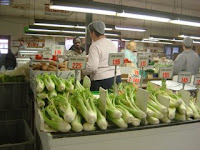Well, well, well. Missing in Action indeed. Just a note to say I AM still alive and I have not given up either on gardening OR on blogging about it. Our home in DC is sold. We are living here full time now. And today with the wind blowing hard enough to shut down the ferries for a second day, we are truly living on an island.
My fence arrangement which has worked for me for almost a decade, was not sufficient to keep out the deer this year. And once they got into the habit of night time visitation, there was no stopping them from marauding through the tomato and green bean crop with a vengeance. I tried holding them off with a makeshift raising of the fence.
I hoped to deter them from nibbling green beans to the ground with help from my local postman.

But each morning brought new heartache. So I decided to give this year up for lost and commit myself anew to next season.
I was lucky that several new VERY local farm stands sprang up this summer to supplement my meager harvest. When I say VERY local I mean that within a half mile bike ride I can get locally grown salad greens, kale, green beans, eggs, yogurt, raw milk, raspberries, heirloom tomatoes and honey. In addition, within that same radius I can purchase locally raised beef, poultry and pork. And I pass everyday the turkey I will eat for Thanksgiving.
I have been busy putting the garden to bed and thinking about the fence I will put in for deer deterrence next spring.















